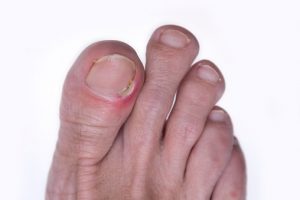Dr. Brian Nagy | April 12th, 2017
Posted In: Ingrown Toenails, Toe Pain
 Your feet bear much of the stress and strains of normal day-to-day life. They absorb the impact of each step you take whether you’re walking, running, or jumping. The feet and toes are made from many small delicate bones, muscles, and tendons that enable these movements. Regardless of your activities and level of athleticism, due to their active role, your toes and feet are prone to injury and painful conditions.
Your feet bear much of the stress and strains of normal day-to-day life. They absorb the impact of each step you take whether you’re walking, running, or jumping. The feet and toes are made from many small delicate bones, muscles, and tendons that enable these movements. Regardless of your activities and level of athleticism, due to their active role, your toes and feet are prone to injury and painful conditions.
When your toe hurts, we provide assessment and treatment for a wide range of toe injuries and conditions to help our patients get back to a pain-free, active life as quickly as possible. No one deserves to live in pain, so learn about about common reasons for toe pain from a New Hampshire podiatrst so that you can recognize your symptoms and seek treatment before the pain gets too bad and interrupts your life.
An ingrown toenail is a very common cause of toe pain that occurs when a toenail grows into the skin and flesh of the toe instead of straight out. Most often found on the big toes, the condition is most commonly caused by cutting your toenails incorrectly. Toenails should be cut straight across, without rounding the corners.
Wearing poorly fitting shoes that squeeze the toes can also contribute to this painful condition. In addition to causing pain, ingrown toenails can cause inflammation and swelling to develop in the affected toe and some people may experience drainage or an odor if an infection develops.
Ingrown toenails don’t always go away on their own and a podiatrist will need to trim the toenail to encourage it to grow correctly. Your podiatrist may also prescribe an antibiotic if the ingrown toenail causes infection.
Bunions are bumps that develop on the side of the foot, usually at the metatarsophalangeal joint where the big toe meets the foot. Bunions form when there is uneven pressure on the bones and tendons of the joint, pushing the toe to point towards the rest of the toes instead of straight out. This leads to deformity and pain.
Bunions are often hereditary, although they may also develop when a person wears poorly fitting shoes. Women are more susceptible to bunions because they are more likely to wear pointed shoes or high heels that compress the toes and put excess pressure on the joints.
The primary symptoms of bunions include the painful bump, inflammation and redness, pain, and the development of corns or other skin irritation due to the bump rubbing against your shoes.
Your podiatrist may suggest using orthotics or physical therapy to readjust the joint, as well as wearing shoes with a wider toe box. In some cases, surgery is necessary to remove any excess bone and restore the joint.
A hammertoe is a deformity in the middle joint of the toe that caused the toe to bend unnaturally. It’s caused by imbalanced pressure on the toes that pulls the muscles, tendons and ligaments out of correct alignment.
Hammertoes are characterized by pain, immobility in the affected toe, and the development of corns or calluses. Your podiatrist will treat your hammertoe with the suggestion to wear different shoes that have enough space for your toes as well as orthotic shoe inserts and exercises to strengthen and reposition the toe.
Common toe injuries include fractures and strains. These are more common in people who participate in athletic activities like jogging, tennis or team sports like football, soccer or basketball.
The best way to avoid injuries is to wear properly fitting footwear and to take care of your feet and toes with correct toenail trimming and stretching the feet. Toe injuries are often best treated with the RICE method (rest, ice, compression, elevation), but you should always have an injury assessed by a professional podiatrist.
If injuries are left untreated they may heal incorrectly, leading to deformity, long lasting pain and mobility issues.
You may also experience toe pain because of arthritis. If your toe hurts and there isn’t an obvious injury or deformity, you may be developing arthritis in your toes. Arthritis is the collective name for a number of conditions that cause pain, inflammation, and swelling in the joints.
Osteoarthritis is the most common form of the disease, which results when the tissue that covers the ends of the bones that meet in a joint wears away, leaving the bones unprotected as they move against each other. Other common forms of arthritis that affect the toes and feet are gout and rheumatoid arthritis. Your podiatrist will need to diagnose the correct type of arthritis before starting treatment.
No matter what is causing your toe to hurt, a New Hampshire podiatrist at Nagy Footcare can provide customized treatment to reduce your pain and help you to get back to normal activities. If your toe hurts or if you have questions about your feet, toes and ankles, contact us today.
« 9 Common Causes of Foot Pain | What is Making Your Bunion Pain Worse? »